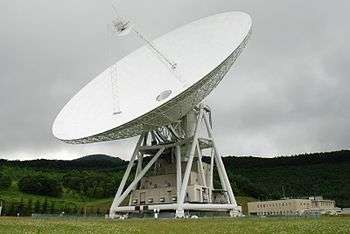Usuda Deep Space Center

Usuda Deep Space Center is a facility of the Japan Aerospace Exploration Agency[1] It is a spacecraft tracking station opened in October, 1984. The main feature of the station is a 64-meter beam waveguide antenna.[2]
Usuda was the first deep-space antenna constructed with beam-waveguide technology. Although this construction dramatically simplifies installation and maintenance of electronics, it was previously thought to offer poor noise performance.[3] However, after the U.S. Jet Propulsion Lab (JPL) tested this antenna and found the noise performance was better than its conventional 64-meter antennas,[4] it too switched to this method of construction for all subsequent antennas of their Deep Space Network (DSN).
Similar huge antennas are used by the deep space networks of the USA, China, Russia, Europe, and India.
References
- ↑ "Usuda Deep Space Center". JAXA.
- ↑ Hayashi, T.; Nishimura, T.; Takano, T.; Betsudan, S.I.; et al. (1994). "Japanese deep-space station with 64-m-diameter antenna fed through beam waveguides and its mission applications". Proceedings of the IEEE. IEEE. 82 (5): 646–657. doi:10.1109/5.284732. ISSN 0018-9219.
- ↑ Layland, J.W. & Rauch, L.L. (1995). "The Evolution of Technology in the Deep Space Network: A History of the Advanced Systems Program" (PDF). National Aeronautics and Space Administration, Jet Propulsion Laboratory, California Institute of Technology. p. 5.
- ↑ Neff, D. Use of a 2.3-GHz Traveling-Wave Maser on the Usuda 64-Meter Antenna (PDF). TDA Progress Report 42 (Technical report). 89. JPL. pp. 34––40.
Coordinates: 36°07′59″N 138°21′44″E / 36.13306°N 138.36222°E